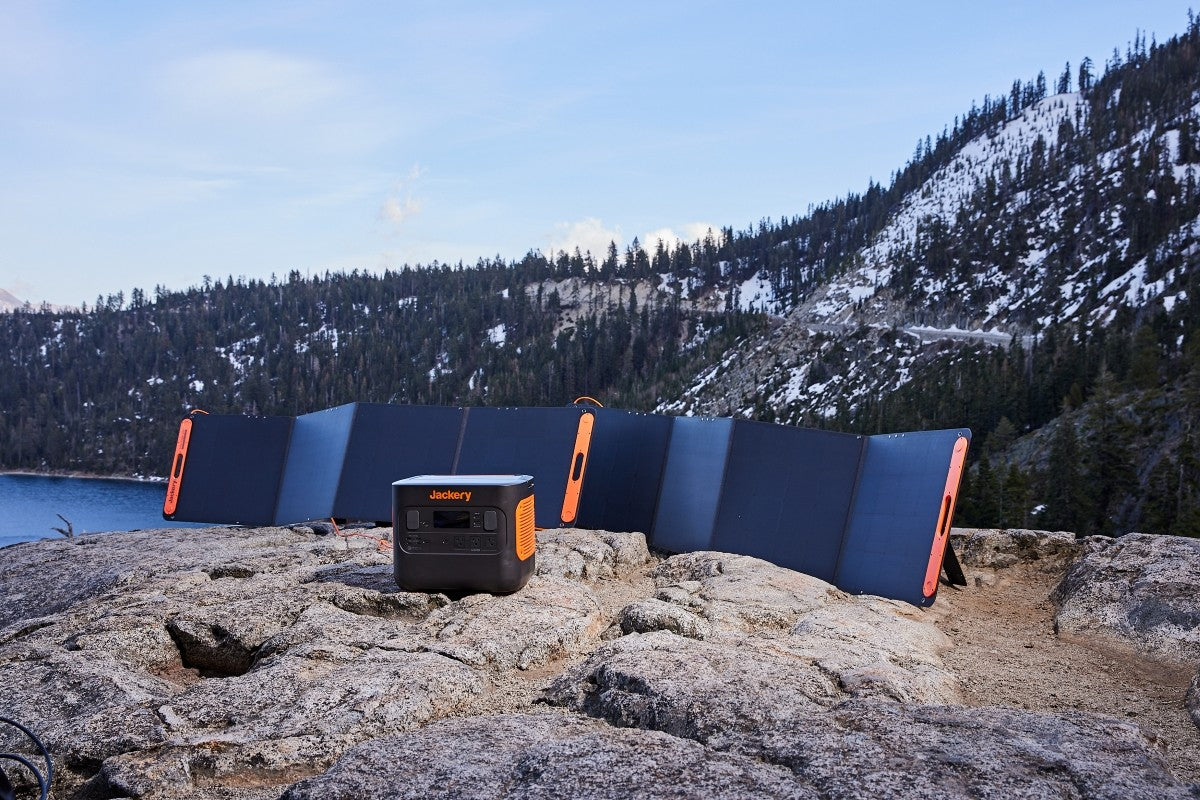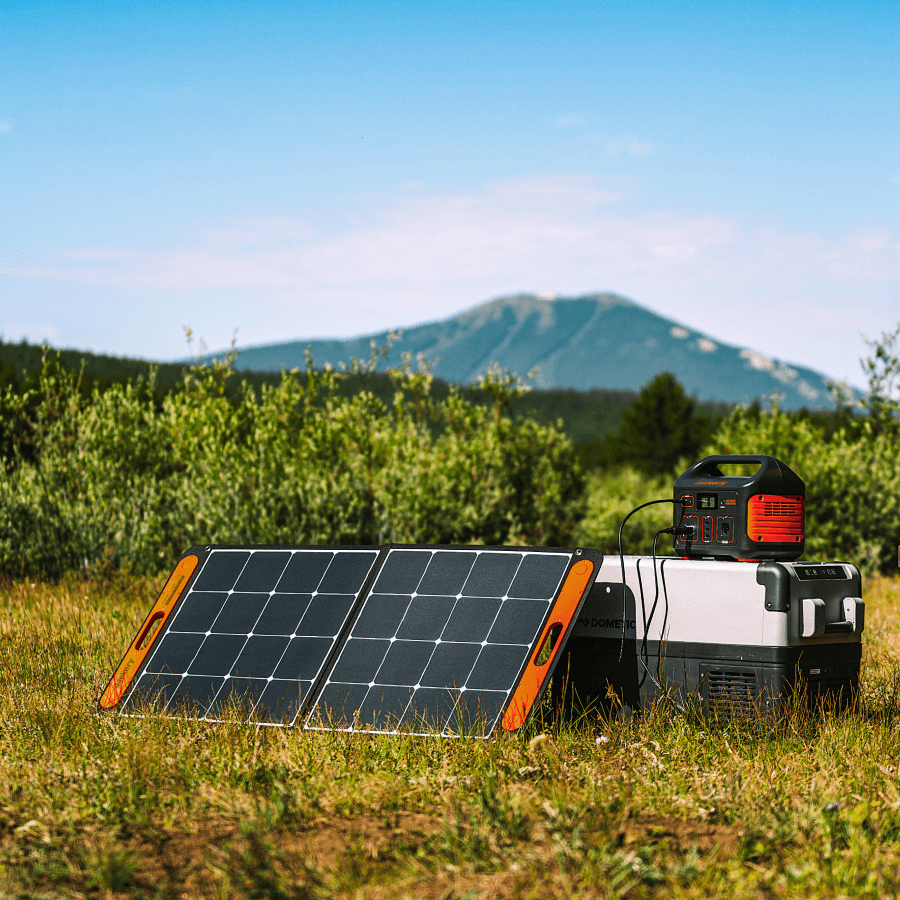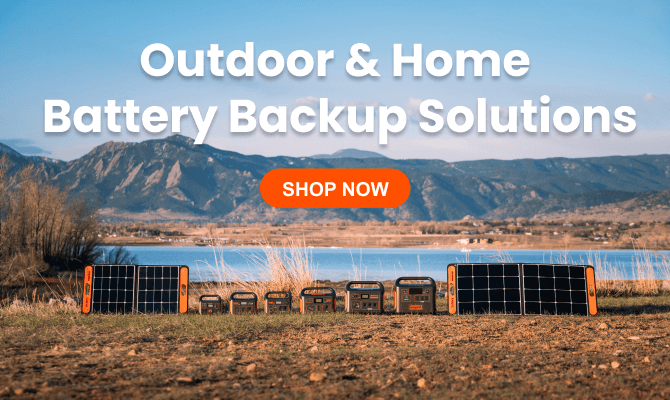Yes, the short answer is that solar generators can run a portable air conditioner. If a power outage happens in your area or the electricity grid fails to supply the electricity, you can charge the portable air conditioner with the solar generator. The solar-powered portable air conditioner can also be carried to outdoor locations so you can stay cool and calm during adventures.
But how does a portable air conditioner work? Well, they cool the space similar to installed AC units but are recharged using solar generators. Jackery offers a reliable range of solar generators for charging small and large appliances, including portable air conditioners. They combine solar panels and power stations to use the free sun's energy and produce electricity.
What Is a Portable Air Conditioner?
A portable air conditioner, also called a stand-up air conditioner, is a type of AC that can be easily moved from one place to another. You can set up these self-contained devices anywhere in any space or beside a window. It has wheels that make placement and movement easier and more convenient.
Pros
- A portable AC is relatively easy to install and does not require any complex installation.
- These air conditioning units have wheels and are lightweight in nature.
- They have a relatively low upfront cost and are ideal for small rooms.
Cons
- You'll need to extract water from the portable aircon for proper functioning.
- They are less energy-efficient and tend to generate some heat during the whole process.
- Portable ACs are relatively noisy compared to their alternatives.
How Does A Portable Air Conditioner Work?
Portable air conditioning units pull the hot air from the room and cool it using the motor to circulate throughout the room. These units typically have three components:
- Refrigerant (to cool the air).
- Compressor (to compress the refrigerant).
- Fan (to circulate the air).

The portable air conditioner has a fan that draws the hot and moist air from an indoor room. The condenser coils inside the units cool down the hot air and extract moisture from the humid air by condensing water vapors.
Once the hot air is transferred to the refrigerant, the energy causes it to heat up and turn into a high-pressure gas that moves through the AC system.
The collected moisture is either removed through a self-evaporative system that vents the water vapor or collected into an internal tank that must be emptied. The portable AC uses an exhaust hose to remove the heat generated within these components.
Single Hose vs. Dual-Hose Portable ACs
Mainly, there are two types of portable room ACs — single-hose and dual-hose — that differ in working. Let's explain them briefly.
Single Hose: These portable aircones typically have a single exhaust vent, which makes them cheaper, easier to install, and more popular. The unit pulls the air to cool it down, and the single hose exhausts the generated moisture/heat.
Since the hose only pulls the room's air and does not replace it, this mechanism creates negative pressure. The air from door gaps and windows comes in to fill the missing air. This leads to the air conditioner working hard to cool the room.
Dual-Hose: Unlike single hoses, the dual hose AC has two separate hoses, which makes them slightly expensive. They have higher efficiency, as dual hoses can draw in fresh air from outside and move out indoor air faster.
How Many Watts Does A Portable AC Use?
The electricity the portable AC uses will fluctuate based on size, energy efficiency, and BTU rating. But how many watts does a portable AC use? The more powerful the AC unit is, the higher the wattage consumption.
BTUs are typically used to represent the cooling power of air conditioning (AC) systems and the heating power of fuel.
In mathematical terms, the watts and BTU are related as follows:
1 BTU = 0.293 watts
There are basically three groups of portable ACs:
- Low-powered evaporative coolers (less than 100W)
- Truly portable camping air conditioners (around 250W)
- Large portable ACs (around 1500W)
- Window AC unit (around 500 - 1500W)
- Central AC unit (around 3000W)
How to Power A Portable Air Conditioner?
There are four ways to power an air conditioner: a power station, power bank, fuel generator, and solar generator. All these charging solutions come with their pros and cons, making it tricky to select the best charging solution.
Portable Power Station: These battery backups can charge your portable air conditioner for long hours. You can use the charging solution to power other appliances, like refrigerators, CPAP machines, etc. However, they require some form of recharging mode.
Power Bank: Power bank chargers are compact, affordable, and valuable to charge small coolers or ACs. However, they are less ideal for larger ACs or other appliances. In addition, you'll need to figure out a way to charge the power bank for the air conditioner.
Fuel Generator: Unlike batteries, fuel or gas generators require some form of energy to work. They emit carbon monoxide, which makes them less ideal for small rooms or spaces. If you use a fuel generator to charge AC, you'll have to keep them in separate rooms.
Solar Generator: Solar generators for AC are portable and affordable solutions ideal for indoor and outdoor purposes. You can not only power air conditioning units but also other home appliances. Unlike fuel generators, they do not emit any fumes or carbon monoxide. The solar panels collect and convert the sun's energy to electricity, which can be safely stored in the battery backup.
|
Types |
Pros |
Cons |
|
Portable Power Station |
They are eco-friendly and do not emit any gases. Many portable power stations have multiple output ports to charge appliances. |
Power output will depend on the battery capacity. |
|
Power Bank |
Power banks are ideal for outdoor adventures. They do not emit any fumes. |
You need to recharge the power bank by buying additional equipment. |
|
Fuel Generator |
They have a low upfront cost. |
Fuel generators emit carbon monoxide or a toxic gas. They are less ideal for small spaces. |
|
Solar Generator |
Solar generators are a clean, renewable energy source. You can use these generators for outdoor and indoor activities. |
High upfront costs. |
Can A Solar Generator Power A Portable AC?
Small generators can safely charge appliances like portable AC for some hours, but you won't be able to plug in multiple high-power-consuming electrical devices. If you want to plug in more devices, using a small generator might lead to overloading and damage.
As a general rule of thumb, an 8000 BTU air conditioner needs less than a 1500W solar generator. Likewise, you'll need a larger solar generator for 16000 BTU air conditioners. Here's a table of minimum-size generators you'll need for different portable AC sizes.
|
Air Conditioner size |
Generator size |
|
8,000 BTU |
>1500W |
|
10,000 BTU |
>2000W |
|
12,000 BTU |
>2500W |
|
14,000 BTU |
>3000W |
|
16,000 BTU |
>3500W |
Jackery can power an RV AC or household air conditioner. It offers a wide range of portable solar generators and portable power stations to charge appliances during power outages, blackouts, and outdoor adventures.These generators combine solar panels and power stations to power all electrical devices. Here's how Jackery Solar Generators work in the form of a diagram.

Here are three popular solar generators for air conditioners.
Jackery Solar Generator 2000 v2
If you want a solar-powered generator that can charge portable ACs in your RV or during car camping, you may go ahead with the Jackery Solar Generator 2000 v2. It's one of the lightest and smallest 2kWh solar generators that can charge 99% of household appliances, including ACs, fans, and other cooling essentials. Its compact design and foldable handle ensure you can move the solar generator anywhere you like.
|
Series |
Capacity |
Lifespan |
Output Ports |
Appliances |
|
Jackery Solar Generator 2000 v2 |
2042Wh |
4000 cycles to 70%+ capacity |
AC Output (x3): 120V ~ 60Hz, 18.3A USB-A Output (x1): 18W Max, 5-6V⎓3A, 6-9V⎓2A, 9-12V⎓1.5A USB-C Output (x2): 30W Max, 5V⎓3A, 9V⎓3A, 12V⎓2.5A, 15V⎓2A, 20V⎓1.5A; 100W Max, 5V⎓3A, 9V⎓3A, 12V⎓3A, 15V⎓3A, 20V⎓5A Car Port (x1): 12V⎓10A Max |
Low-Powered Evaporative Coolers (100W): H Portable Camping AC (250W): H Large Portable AC (1500W): H Window Ac Unit (500 - 1500W): H Central AC Unit (3000W): H |
Jackery Solar Generator 2000 Plus
The Jackery Solar Generator 2000 Plus is an expandable solar-powered generator that can charge 99% of your household or outdoor appliances, such as air conditioners and portable fans. It is compatible with the Jackery Battery Pack 2000 Plus, which extends the battery capacity from 2kWh to 24kWh, allowing you to charge almost all household appliances during long-term power outages and blackouts.
|
Series |
Capacity |
Lifespan |
Output Ports |
Appliances |
|
Jackery Solar Generator 2000 Plus |
2042.8Wh |
4000 cycles to 70%+ capacity |
AC Output (x4): 120V~ 60Hz, 20A Max AC Output (x1): 120V~ 60Hz, 25A Max USB-A Output (x1): Quick Charge 3.0, 18W Max USB-C Output (x2): 100W Max, (5V, 9V, 12V, 15V, 20V up to 5A) Car Port (x1): 12V⎓10A Max |
Low-Powered Evaporative Coolers (100W): 17.3H Portable Camping AC (250W): 6.9H Large Portable AC (1500W): 1.1H Window Ac Unit (500 - 1500W): 1.1 - 3.4H
|
Jackery Solar Generator 5000 Plus
The Jackery Solar Generator 5000 Plus is a whole-home solar generator that can charge almost all household appliances, including ACs, during long-term power outages. It can be connected to the home's electricity system and offers 0ms UPS support to switch from on-grid power to battery backup instantly. With the additional Jackery Battery Pack 5000 Plus, you can also expand the battery capacity from 5kWh to 60kWh.
|
Series |
Capacity |
Lifespan |
Output Ports |
Appliances |
|
Jackery Solar Generator 5000 Plus |
5040Wh |
4000 cycles to 70%+ capacity |
AC Output (x4): 120V, 20A, 2400W USB-A Output (x2): 18W Max, 5-6V⎓3A, 6-9V⎓2A, 9-12V⎓1.5A USB-C Output (x2): 100W Max, 5V⎓3A, 9V⎓3A, 12V⎓3A, 15V⎓3A, 20V⎓5A Car Port (x1): 12V⎓10A Max |
Low-Powered Evaporative Coolers (100W): 42.8H Portable Camping AC (250W): 17.1H Large Portable AC (1500W): 2.8H Window Ac Unit (500 - 1500W): 2.8 - 8.5H Central AC Unit (3000W): 1.4H |
How to Choose A Solar Generator for Portable AC?
Not all portable AC chargers are created equal. They may vary depending on capacity, power output, and other factors. That's why choosing a solar generator for portable AC depends on capacity, output wattage, output ports, recharge time, and weight.
Battery Capacity: The battery backup capacity will depend on the power required to charge the AC. It's always better to have an extra window of battery capacity that will supply uninterrupted electricity to appliances like air conditioning units.
Output Ports: The number of output ports defines how many appliances you can charge simultaneously. Jackery Explorer Portable Power Stations have multiple output ports to charge various electrical devices at the same time.
Recharge Time: When choosing a portable power station for your household AC, you must ensure it has a shorter recharge time. In this case, investing in a solar generator with a pass-through charging facility ensures the AC remains functional even when the power station is being charged.
Weight: Lastly, you should consider the dimensions or total weight of the AC charger. While the size and weight will depend on the capacity, it is ideal to look for a solar generator with wheels for maximum portability.
While selecting the battery backup for AC, you'll need to ensure it can quickly meet your power requirements and is safe.
Final Thoughts
Now that we have discussed how does a portable air conditioner works and how to charge AC, it's time to choose the ideal charging solution. Using a solar generator to charge an air conditioner is not only possible but also highly beneficial and cost-effective in the long run.
With Jackery, you'll find various power options that will fit your budget and your charging requirements. For example, Jackery Solar Generator 2000 Pro charges large ACs, while Solar Generator 500 might be an ideal choice for smaller air conditioning units.






















































































































What size generator can support a mobile air conditioner
Leave a comment